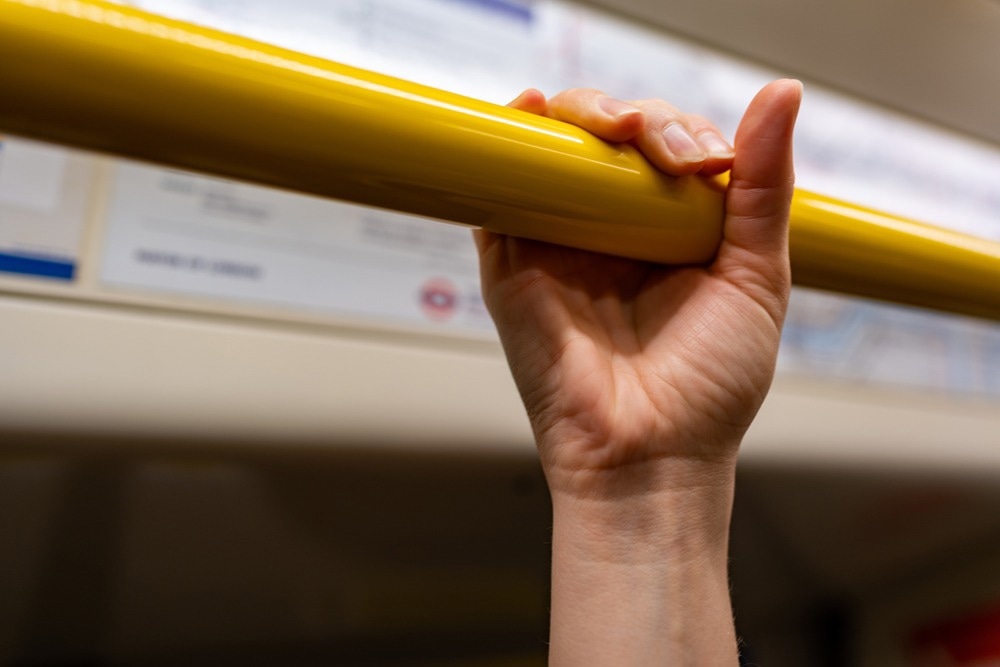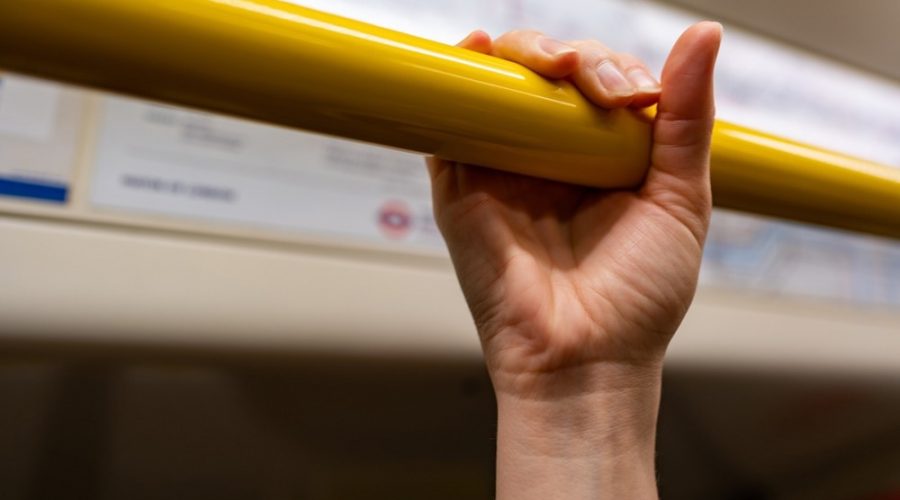Antimicrobial coating reduces spread of SARS-CoV-2 on public transport
Several viruses are transmitted through direct contact with surfaces contaminated with body fluids or soiled hands of infected individuals. In addition, the deposition of aerosolized viral particles can also contaminate surfaces.
Contaminated surfaces act as fomites; however, this mode of viral transmission is not considered the primary transmission route for the severe acute respiratory syndrome coronavirus 2 (SARS-CoV-2), which is the causal agent of the coronavirus disease 2019 (COVID-19).

Study: Laboratory evaluation of a quaternary ammonium compound (QAC)-based antimicrobial coating used in public transport during the COVID-19 pandemic. Image Credit: Georgios Karkavitsas / Shutterstock.com
Background
Although the risk of SARS-CoV-2 transmission after brief contact with a contaminated surface is low, it increases when individuals touch a higher number of contaminated surfaces. Therefore, viral transmission through fomites depends on several factors, including the density of individuals, number of contacts by the contaminated hand, and duration of stay within a venue, along with adherence to mitigation strategies, such as frequent hand washing and use of surface decontaminants.
Typically, while using public transportation, there is an increased chance of touching many surfaces, such as seat headrests, poles, armrests, push buttons, and tables. The implementation of travel restrictions between 2020 and 2021 led to around 388 million rail passenger journeys recorded in Great Britain, significantly lower than the 990 million journeys reported between 2021 and 2022.
The role of infection transmission through public transport is not well documented. Nevertheless, preliminary epidemiological evidence describes how high-touch surfaces on public transport vehicles are contaminated with pathogens like bacteria and viruses.
There remains an urgent need for more research to elucidate optimal practices for the public transport sector to prevent viral infection through contaminated surfaces. In addition to enhanced cleaning measures, some transport operators in the United Kingdom have used antimicrobial coatings, which reduce surface bioburden and viral contamination.
Several commercially available antimicrobial products are applied onto the surfaces of public transport vehicles to confer long-lasting antimicrobial activity when used alongside regular cleaning. These coatings also supplement standard disinfection practices.
About the study
Scarce real-time evidence has been documented that supports manufacturers' claims of prolonged antimicrobial activity of coatings applied in public settings. However, a recent study published on the bioRxiv* preprint server evaluates the antiviral efficacy of a quaternary ammonium compound (QAC)-based antimicrobial coating that has been widely used by the U.K. rail industry throughout the ongoing COVID-19 pandemic. To assess the antiviral efficacy of the product, bacteriophage ɸ6 was used as a surrogate for SARS-CoV-2.
Previous studies have reported the effectiveness of QAC-based products in industrial, healthcare, and domestic settings against SARS-CoV-2. In addition, these cationic detergents contain substantial varieties of chemical structures, thus making them suitable for a wide range of applications, such as the inactivation of viruses, bacteria, and yeast.
Study findings
In laboratory settings, quaternary ammonium polymer-based coatings exhibited significantly high virucidal efficacy against SARS-CoV-2 and its surrogates ɸ6 and human coronavirus 229E when applied to stainless steel, acrylonitrile butadiene Styrene (ABS) plastic, poly(methyl methacrylate) coupons, and polystyrene. However, when the antimicrobial coating was tested on other frequently used materials associated with the transportation industry, it was associated with varying levels of efficacy.
The QAC-based antimicrobial coating was associated with high antiviral activity when applied to a plastic-coated hand pole and high-pressure laminate tray table. Nevertheless, high variability in the efficacy between replicates was observed when it was coated on glass.
No antiviral activity was found for the Terluran armrest. This finding is significant, as the manufacturers claimed that the coating was effective on all materials. Furthermore, in the absence of interfering substances, contact times of at least 15 minutes are required to achieve less than 3log10 reductions.
In public transport, organic debris is frequently deposited on surfaces. This condition was replicated by adding a layer of bovine serum albumin (BSA) or fetal bovine serum (FBS) over the coating.
BSA did not interfere with the product; however, antiviral activity was reduced when the FBS layer was applied to test coupons. Application of the FBS layer to the coated train parts showed no virucidal activity.
Since the product was designed to be used alongside regular cleaning, the researchers assessed whether wiping could affect the efficacy of the coating. In the presence of FBS, wiping with a wet cloth did not resume the product's efficacy, thus indicating that wiping with a damp cloth likely removed the coating from the surface.
 Efficacy of Zoono Z71 when applied to a tray table (HPL- high pressure laminate; SS-stainless steel), in the presence or absence of FBS, after wiping with a wetted cloth in comparison with non-wiped controls. Two wiping protocols differing in the number of wipes were applied. Efficacy was calculated as the average log10 reduction (n=2 with 3 replicates each) from ϕ6 pfu/replicate immediately after inoculation (time=0) minus ϕ6 pfu/replicate after 120 minutes. Errors bars represent standard deviation. Undetected virus observations were assumed to have a concentration of 20 PFU/replicate, the theoretical detection limit, for analysis.
Efficacy of Zoono Z71 when applied to a tray table (HPL- high pressure laminate; SS-stainless steel), in the presence or absence of FBS, after wiping with a wetted cloth in comparison with non-wiped controls. Two wiping protocols differing in the number of wipes were applied. Efficacy was calculated as the average log10 reduction (n=2 with 3 replicates each) from ϕ6 pfu/replicate immediately after inoculation (time=0) minus ϕ6 pfu/replicate after 120 minutes. Errors bars represent standard deviation. Undetected virus observations were assumed to have a concentration of 20 PFU/replicate, the theoretical detection limit, for analysis.
Conclusions
The current study emphasized the importance of evaluating QAC-based antimicrobial coatings on different materials, including relevant interfering substances.
The product assessed in this study exhibited a rapid reduction in antiviral activity due to the accumulation of organic debris. In the future, more studies are needed to formulate effective prevention and control strategies for public transport.
*Important notice
bioRxiv publishes preliminary scientific reports that are not peer-reviewed and, therefore, should not be regarded as conclusive, guide clinical practice/health-related behavior, or treated as established information.
- Aranega-Bou, P., Brown, N., Stigling, A., et al. (2022) Laboratory evaluation of a quaternary ammonium compound (QAC)-based antimicrobial coating used in public transport during the COVID-19 pandemic. bioRxiv. doi:10.1101/2022.10.12.512011. https://www.biorxiv.org/content/10.1101/2022.10.12.512011v1.abstract.
Posted in: Medical Science News | Medical Research News | Disease/Infection News
Tags: Albumin, Bacteria, Bacteriophage, Body Fluids, Bovine Serum Albumin, Compound, Contamination, Coronavirus, Coronavirus Disease COVID-19, covid-19, Disinfection, Efficacy, Healthcare, Laboratory, Pandemic, Research, Respiratory, SARS, SARS-CoV-2, Severe Acute Respiratory, Severe Acute Respiratory Syndrome, Syndrome, Virus, Yeast

Written by
Dr. Priyom Bose
Priyom holds a Ph.D. in Plant Biology and Biotechnology from the University of Madras, India. She is an active researcher and an experienced science writer. Priyom has also co-authored several original research articles that have been published in reputed peer-reviewed journals. She is also an avid reader and an amateur photographer.
Source: Read Full Article
